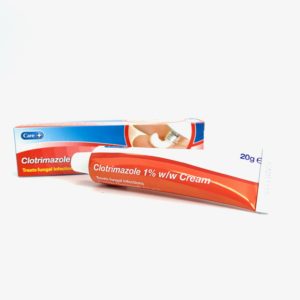A fungal infection can affect any part of the body but it is only when they overgrow does an infection occur and can include common infections such as Athlete’s foot, Jock itch, Thrush and ringworm.
Fungi love warm, moist areas of the body especially folds in the skin (such as between your toes). A fungal nail infection will normally affect the toes rather than the fingernails and often the infected toenail originates from Athlete’s foot (it is the same fungi). What happens is the nail bed becomes infected so although the athlete’s foot infection is often easily treated with a topical cream containing Clotrimazole, the cream cannot penetrate the nail to kill the fungus that exists in the nail bed so the nail becomes more and more infected.
Fungal infections are very common and very contagious so are spread between people very easily – e.g. from the floors of showers/swimming pools. Increasingly infections of the nails are being caused by manicures and pedicures where tools such as emery boards and nail clippers are not sanitized before use.
It is estimated that at any one time over a million people in the UK have a fungal nail infection. It is easily treated but if left untreated can become a serious and painful infection.
What are the symptoms of a fungal nail infection?
A fungal nail infection usually starts at the edge of the nail and can take on a slight yellowy brown hue. As the infection gets worse it will become more discoloured and spread to the middle and even the base of the nail. The nail lifts off the nail bed and becomes brittle and pieces can easily break off.
If the infection remains untreated and becomes very severe the nail can become misshapen and fall out, making walking painful.
How is a Fungal Nail Infection treated?
Over the counter products can resolve the problem in mild cases but are not always reliable. It is always advisable to have any nail infection checked by your doctor as the nail problem can have other causes and often a nail sample or scraping are taken and sent for analysis.
In severe cases the doctor may prescribe an oral antifungal medicine with an active ingredient such as Terbinafine or Itraconazole.
It is especially important if you suspect a fungal nail infection and you also have diabetes that you visit your doctor as soon as possible. A person with diabetes is at risk of suffering serious complications if a fungal nail infection goes untreated.
How to try and prevent Fungal Nail Infections
There are some basic tips that will help to keep your nails free of infection and are similar to those for preventing other fungal infections such as Thrush and Athlete’s Foot.

Please note that you can NOT buy the following combinations of medicines.
If purchasing separately the maximum number of tablets is 96 of each type. If purchasing as a combination then the maximum allowed is 96 tablets in total.
The maximum number of tablets is 96 of each type of the following medicine combinations;
The maximum number of Co-codamol you’re allowed to purchase is 32 tablets.
If you have any additional questions please Contact Us
The New Model from SD Biosensor (the manufacturers of the No.1 selling SD Codefree Blood Glucose Meter) has all the benefits of the Codefree plus it boasts a greater accuracy due to a wider haematocrit (HCT) range of 0-70% and GDH-FAD enzyme technology.
All of this with prices starting from just £11.99!
Click here to find out more information.
